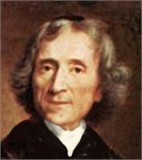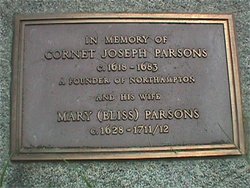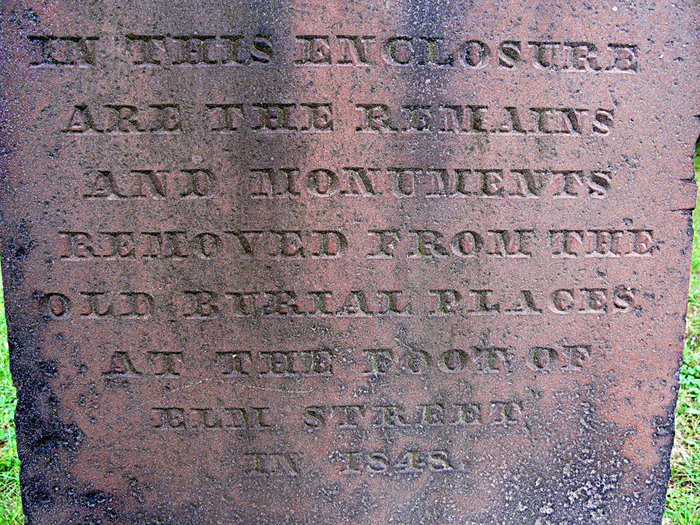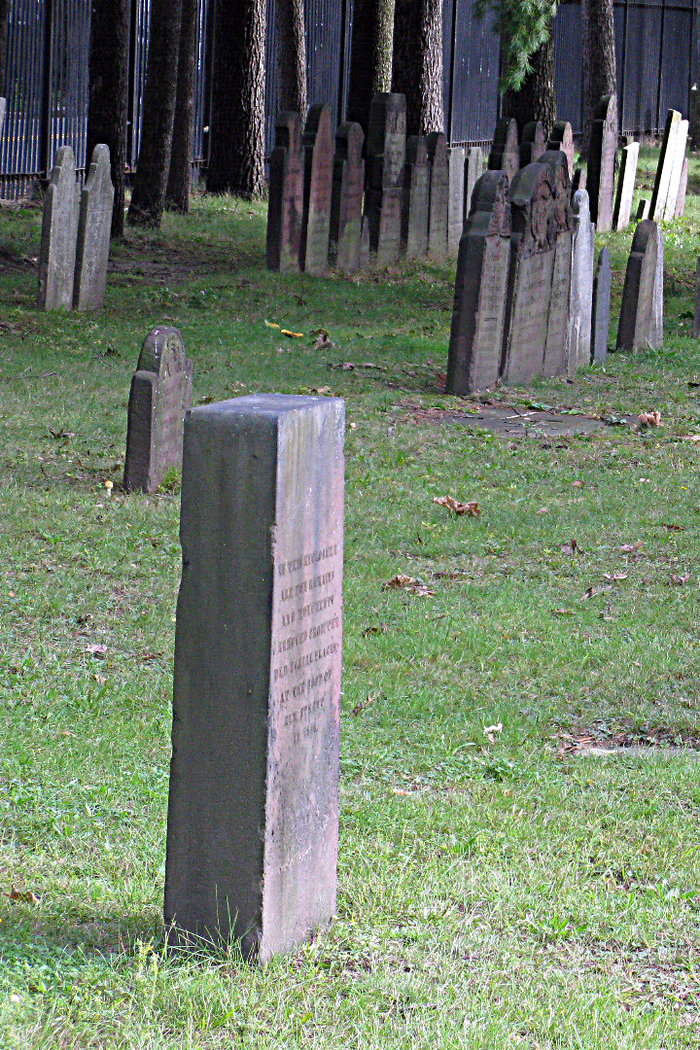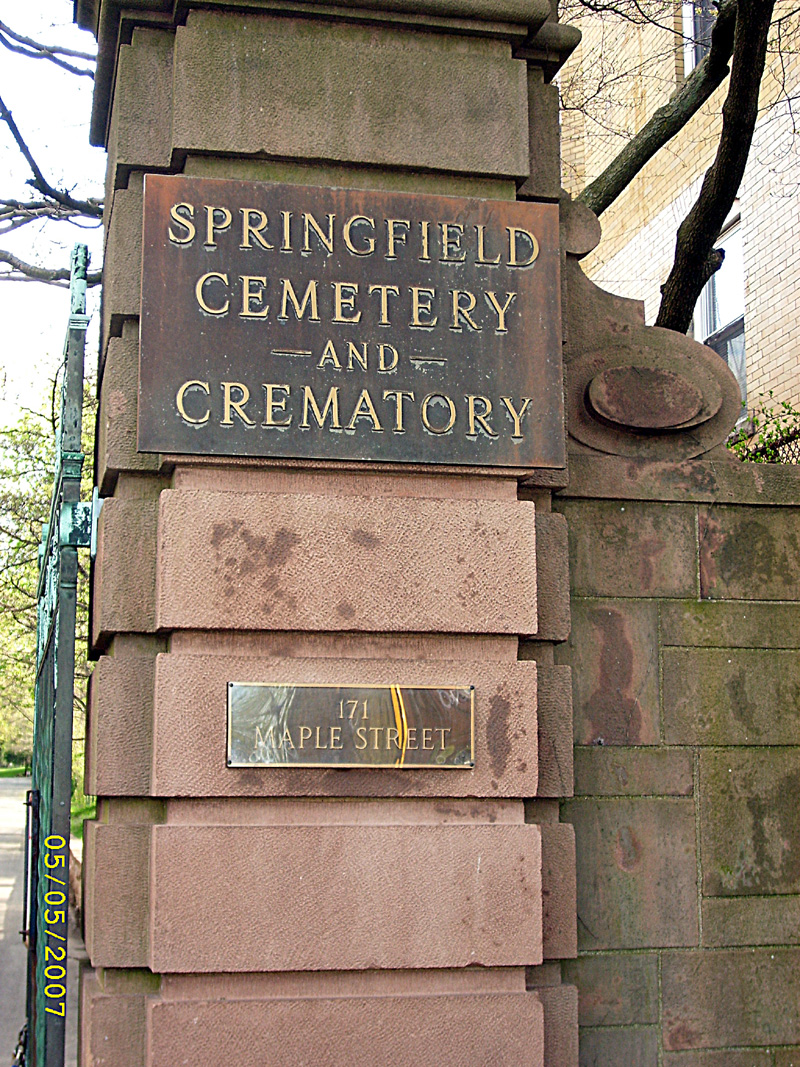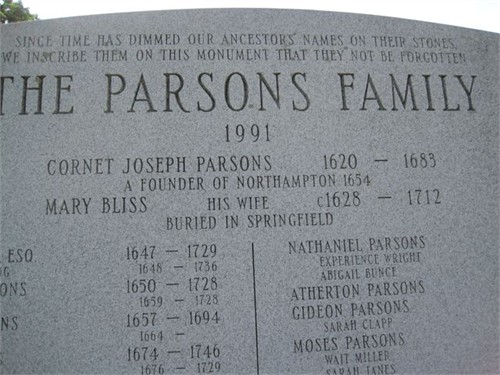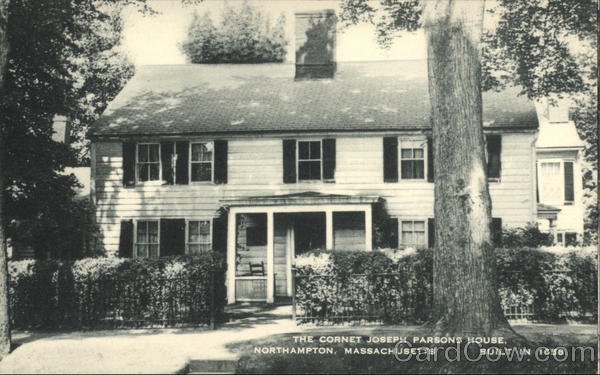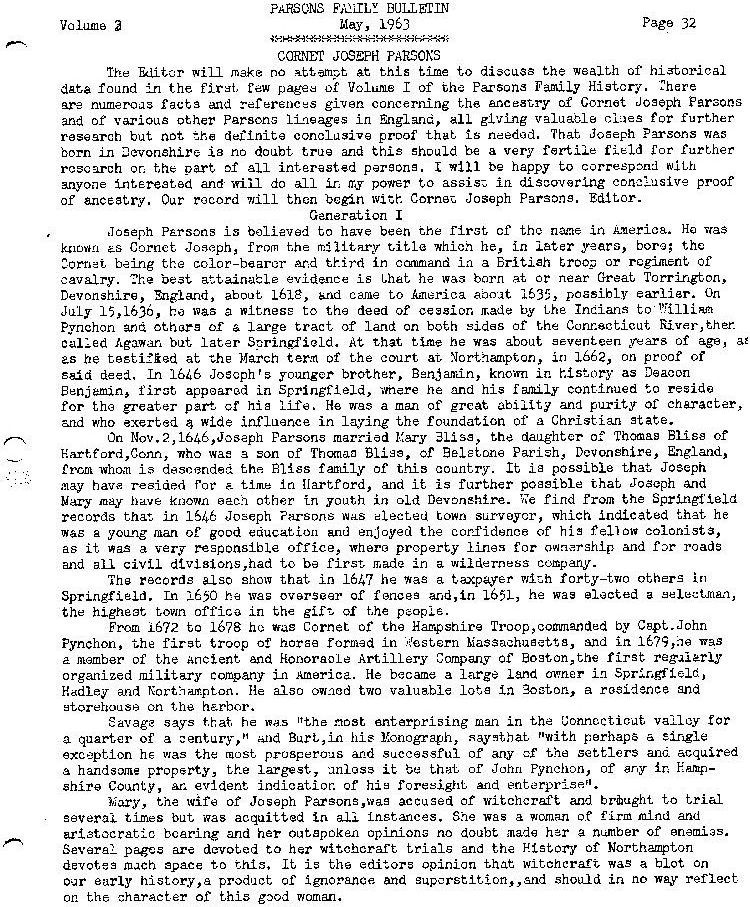"Born the son of William Parsons and Margaret (Hoskins) Parsons of Beaminster, Co. Dorset, England. Married Mary Bliss on November 26, 1646
Father of:
Joseph Parsons Jr, Benjamin Parsons, John Parsons, Samuel Parsons, Ebenezer Parsons, Jonathan Parsons, David Parsons, Mary (Parsons) Ashley Williston, Hannah (Parsons) Glover, Abigail (Parsons) Colton, and Esther (Parsons) Smith.
Although there are only 11 children listed, conflicting documentation suggests a 12th child.
Thank you to Kevin Avery for the childrens names listed above and a number of links to this memorial."
_____________
The following information has been garnered from various sources, marking the well-documented life of Joseph Parsons Sr:
Joseph Parsons (1620-1683), known in many subsequent records by his military title, Cornet Joseph Parsons, came to America as a boy but earned prominence as a public servant and founder of towns, which grew into cities.
Joseph was the child of Margaret Hoskins (c. 1584-?) and William Parsons (?-?). His maternal grandparents were Robert and Margret Hoskins, one of two couples of that name in Beaminster, England, both of whom had a daughter named Margaret.
Joseph Parsons was born in Beaminster about 1620 and came to Massachusetts in 1635 (perhaps with a brother, Benjamin) aboard the Transport (Edward Walker, Master) out of Gravesend, County Kent.
Joseph Parsons received many notations in colonial town records. Young Joseph is mentioned as a witness to a deed on July 15, 1636 in Springfield, MA. The deed was between Joseph Pyncheon and local Indians. The wealthy Pincheon may have sponsored his young friend (or relative?) in establishing himself in Springfield as well as in Northampton.
In 1646, Joseph was appointed highway surveyor of Springfield, holding this position in 1653. In 1652, Joseph was elected a Springfield Selectman but was living in Northampton, MA by 1655. In December of 1656 in Northampton, Joseph Parsons was elected to the Board of Selectmen. He served as Selectman in 1659, 1664, 1667, and 1670. Joseph served frequently as a juror.
In 1834, an examination of Northampton records by Dr. Usher Parsons revealed that Joseph Parsons' house lot covered four acres. He bought an adjoining lot and in 1661, was licensed to keep "an ordinary," or house of entertainment in Northampton. Also in 1661, Joseph Parsons was made a member of a committee to lay out the plans of the Meeting House and residence for the Rev. Eleazer Mather, first minister of Northampton. In this same year, Joseph was on a committee to meet with counterparts of Newtown, MA to see to the establishment of a road between Newtown and Northampton; in 1670, Joseph Parsons was made a member of the committee to construct a "Cart bridge" over the Munhan River.
Joseph Parsons was one of two persons of Northampton licensed to trade with Native Americans. It is supposed that this trade was primarily in furs. A common practice was for a trader to offer money or articles of value in exchange for the promised delivery of furs, which would then be sold at a great mark-up. If the fur delivery was defaulted, land would be exchanged for the debt. Joseph Parsons seems to have obtained much land by this means, including land upon which was established the town of Hadley, MA.
The 1834 Usher Parsons study reported that Joseph Parsons owned 100 acres at the foot of Mount Tom, at a place called Pascommuck. Joseph Parsons "for half a century remained the richest man in the Connecticut Valley" (manuscript of Dr Holton, family genealogist, quoted in Burt's CORNET JOSEPH PARSONS, 1898, page 93).
On Nov 26, 1646, Joseph Parsons married Mary Bliss (?-?) in Hartford, CT. They became the parents of 13 children, 5 girls and 8 boys. It seems probable their first three children (Joseph Jr, Benjamin, John) were born in Hartford, as their births were not recorded in Springfield.
Joseph Jr. was the father of four sons, Ebenezer, Daniel, Moses and David, through whom Joseph Jr and Sr are ancestors of this contributor.
In Dorchester, in 1656, almost 40 years before the witchcraft travesty in Salem, MA, Joseph Parsons filed a lawsuit for slander, seeking damages against Sarah Bridegman, wife of James Bridgman. The suit accused Sarah Bridgeman of calling Mary Bliss Parsons a witch. Sarah Bridgeman's child had died and she accused Mary Parsons of causing the child's death. Other neighbors came forward with similar accusations. The quality of the evidence produced against Mary Bliss Parsons is indicated by testimony of Mrs Bridgeman on behalf of an older son, whose knee, being fractured and it being set, the child screamed in great pain that Mary Parsons was pulling his leg off and that he saw her on the shelf; when she went away, a black mouse followed her. Trial resulted in a verdict for Mary Parsons, which prompted the suit for slander, won by Joseph and Mary Bliss Parsons. The defendants were order to make a public apology and to pay the plaintiffs' costs: "seaven pounds, one shilling and eight pence."
But the matter did not end there.
Nineteen years later, in 1675, Mary Parsons was again accused of witchcraft when Sarah Bridgman herself died. These accusations, made by the father and the husband of the deceased, prompted the prosecution of Mary Bliss Parsons. Mary was indicted by a grand jury and imprisoned in Boston for several months and then put on trial. Her ordeal included the examination of her person by "Soberdized, Chast women to make Diligent Search upon ye body of Mary Parsons, whether any marks of witch craft might appear." She was acquitted.
Such allegations as were made against Mary Bliss Parsons, by neighbors of long standing, living within minutes of one another's homes, treating with one another virtually every day, parents of families, whose children would have know one another in every aspect of small town life – such life-threatening denunciations must surely have sundered many friendships and provoked the deepest of bitter feelings. Dorchester, after 1656, like Salem after 1691, could not have been a happy place. In this the first American generation, the Puritan experiment had turned toxic within itself.
In 1664, Joseph Parsons was charged with resisting a constable in his lawful duties. Court records indicate that the constable had meant to appropriate oxen belonging to Joseph Parsons for use on a public project, as decreed by county authorities. There followed "Scuffling in the busyness whereby blood was drawn between them." The charge was not denied and Joseph sold an acre and a half to the town in payment of the fine, part of which was abated owing to Joseph's apology.
Joseph was the plaintiff or defendant in several suits over money owed. Some of these were settled out of court; in some cases, payment was made through the court or a parcel of land would be sold to satisfy the debt.
Joseph Parsons' business records are deposited in the Springfield, MA, Library.
On the 7th of October 1678, the General Court appointed Joseph Parsons, Sr. to be "Cornet of the Troop of Hoarse," Hampshire Co. (Maj. John Pynchon, commander). With this appointment, Joseph was third in command and the color-bearer of the Hampshire Cavalry.
Joseph Parsons died on October 9, 1683. He was probably buried in the Elm Street cemetery, in Springfield, and in 1848, reburied in a mass grave near the Pine Street entrance to the present Springfield Cemetery, when land within the cemetery was needed for the Hartford-Springfield railroad.
NOTE: Contributor Gary A. Parsons (#47275392) Historian for the Parsons Family Association of New England and Web Page Administrator for the PFA's Western Region, has asked that a comment of his be included in this memorial; Gary also wishes to acknowledge that the below information came to his notice by way of the late Mr. Gerald J. Parsons, F.A.S.G. Gary Parsons' note is therefore added, with appreciation:
"When the railroad cut through a corner of the old Elm Street Cemetery in 1848, they had to move some of the graves to a new location. That new location was the Springfield City Cemetery at 171 Maple Street, against the back fence. Graves with undamaged headstones were moved intact. However, graves with broken or no headstones were re-interred into a single mass grave, and a new headstone erected. Unfortunately, Cornet Joseph Parsons and his wife, Mary Bliss are in this mass grave."
_________
Quotations are found in Burt's CORNET JOSEPH PARSONS (1898). See also PARSONS FAMILY, Henry Parsons (Vol 1, 1912; Vol 2, 1920).
Much additional data about the Parsons family may be found in the book ALL OF THE ABOVE I, by Richard Baldwin Cook (Nativa, 2007, revised 2008). For further details, please see this contributor's main page.
See also: THE PARSONS FAMILY, Volume 1. The English Ancestry and Descendants to the Sixth Generation of Cornet Joseph Parsons (1620-1683), Springfield, Massachusetts, 1636, Northampton, Massachusetts, 1654. Compiled by Gerald James Parsons, A.B., M.S.L.S., Published by Gateway Press, Baltimore, MD, 2002.
"Born the son of William Parsons and Margaret (Hoskins) Parsons of Beaminster, Co. Dorset, England. Married Mary Bliss on November 26, 1646
Father of:
Joseph Parsons Jr, Benjamin Parsons, John Parsons, Samuel Parsons, Ebenezer Parsons, Jonathan Parsons, David Parsons, Mary (Parsons) Ashley Williston, Hannah (Parsons) Glover, Abigail (Parsons) Colton, and Esther (Parsons) Smith.
Although there are only 11 children listed, conflicting documentation suggests a 12th child.
Thank you to Kevin Avery for the childrens names listed above and a number of links to this memorial."
_____________
The following information has been garnered from various sources, marking the well-documented life of Joseph Parsons Sr:
Joseph Parsons (1620-1683), known in many subsequent records by his military title, Cornet Joseph Parsons, came to America as a boy but earned prominence as a public servant and founder of towns, which grew into cities.
Joseph was the child of Margaret Hoskins (c. 1584-?) and William Parsons (?-?). His maternal grandparents were Robert and Margret Hoskins, one of two couples of that name in Beaminster, England, both of whom had a daughter named Margaret.
Joseph Parsons was born in Beaminster about 1620 and came to Massachusetts in 1635 (perhaps with a brother, Benjamin) aboard the Transport (Edward Walker, Master) out of Gravesend, County Kent.
Joseph Parsons received many notations in colonial town records. Young Joseph is mentioned as a witness to a deed on July 15, 1636 in Springfield, MA. The deed was between Joseph Pyncheon and local Indians. The wealthy Pincheon may have sponsored his young friend (or relative?) in establishing himself in Springfield as well as in Northampton.
In 1646, Joseph was appointed highway surveyor of Springfield, holding this position in 1653. In 1652, Joseph was elected a Springfield Selectman but was living in Northampton, MA by 1655. In December of 1656 in Northampton, Joseph Parsons was elected to the Board of Selectmen. He served as Selectman in 1659, 1664, 1667, and 1670. Joseph served frequently as a juror.
In 1834, an examination of Northampton records by Dr. Usher Parsons revealed that Joseph Parsons' house lot covered four acres. He bought an adjoining lot and in 1661, was licensed to keep "an ordinary," or house of entertainment in Northampton. Also in 1661, Joseph Parsons was made a member of a committee to lay out the plans of the Meeting House and residence for the Rev. Eleazer Mather, first minister of Northampton. In this same year, Joseph was on a committee to meet with counterparts of Newtown, MA to see to the establishment of a road between Newtown and Northampton; in 1670, Joseph Parsons was made a member of the committee to construct a "Cart bridge" over the Munhan River.
Joseph Parsons was one of two persons of Northampton licensed to trade with Native Americans. It is supposed that this trade was primarily in furs. A common practice was for a trader to offer money or articles of value in exchange for the promised delivery of furs, which would then be sold at a great mark-up. If the fur delivery was defaulted, land would be exchanged for the debt. Joseph Parsons seems to have obtained much land by this means, including land upon which was established the town of Hadley, MA.
The 1834 Usher Parsons study reported that Joseph Parsons owned 100 acres at the foot of Mount Tom, at a place called Pascommuck. Joseph Parsons "for half a century remained the richest man in the Connecticut Valley" (manuscript of Dr Holton, family genealogist, quoted in Burt's CORNET JOSEPH PARSONS, 1898, page 93).
On Nov 26, 1646, Joseph Parsons married Mary Bliss (?-?) in Hartford, CT. They became the parents of 13 children, 5 girls and 8 boys. It seems probable their first three children (Joseph Jr, Benjamin, John) were born in Hartford, as their births were not recorded in Springfield.
Joseph Jr. was the father of four sons, Ebenezer, Daniel, Moses and David, through whom Joseph Jr and Sr are ancestors of this contributor.
In Dorchester, in 1656, almost 40 years before the witchcraft travesty in Salem, MA, Joseph Parsons filed a lawsuit for slander, seeking damages against Sarah Bridegman, wife of James Bridgman. The suit accused Sarah Bridgeman of calling Mary Bliss Parsons a witch. Sarah Bridgeman's child had died and she accused Mary Parsons of causing the child's death. Other neighbors came forward with similar accusations. The quality of the evidence produced against Mary Bliss Parsons is indicated by testimony of Mrs Bridgeman on behalf of an older son, whose knee, being fractured and it being set, the child screamed in great pain that Mary Parsons was pulling his leg off and that he saw her on the shelf; when she went away, a black mouse followed her. Trial resulted in a verdict for Mary Parsons, which prompted the suit for slander, won by Joseph and Mary Bliss Parsons. The defendants were order to make a public apology and to pay the plaintiffs' costs: "seaven pounds, one shilling and eight pence."
But the matter did not end there.
Nineteen years later, in 1675, Mary Parsons was again accused of witchcraft when Sarah Bridgman herself died. These accusations, made by the father and the husband of the deceased, prompted the prosecution of Mary Bliss Parsons. Mary was indicted by a grand jury and imprisoned in Boston for several months and then put on trial. Her ordeal included the examination of her person by "Soberdized, Chast women to make Diligent Search upon ye body of Mary Parsons, whether any marks of witch craft might appear." She was acquitted.
Such allegations as were made against Mary Bliss Parsons, by neighbors of long standing, living within minutes of one another's homes, treating with one another virtually every day, parents of families, whose children would have know one another in every aspect of small town life – such life-threatening denunciations must surely have sundered many friendships and provoked the deepest of bitter feelings. Dorchester, after 1656, like Salem after 1691, could not have been a happy place. In this the first American generation, the Puritan experiment had turned toxic within itself.
In 1664, Joseph Parsons was charged with resisting a constable in his lawful duties. Court records indicate that the constable had meant to appropriate oxen belonging to Joseph Parsons for use on a public project, as decreed by county authorities. There followed "Scuffling in the busyness whereby blood was drawn between them." The charge was not denied and Joseph sold an acre and a half to the town in payment of the fine, part of which was abated owing to Joseph's apology.
Joseph was the plaintiff or defendant in several suits over money owed. Some of these were settled out of court; in some cases, payment was made through the court or a parcel of land would be sold to satisfy the debt.
Joseph Parsons' business records are deposited in the Springfield, MA, Library.
On the 7th of October 1678, the General Court appointed Joseph Parsons, Sr. to be "Cornet of the Troop of Hoarse," Hampshire Co. (Maj. John Pynchon, commander). With this appointment, Joseph was third in command and the color-bearer of the Hampshire Cavalry.
Joseph Parsons died on October 9, 1683. He was probably buried in the Elm Street cemetery, in Springfield, and in 1848, reburied in a mass grave near the Pine Street entrance to the present Springfield Cemetery, when land within the cemetery was needed for the Hartford-Springfield railroad.
NOTE: Contributor Gary A. Parsons (#47275392) Historian for the Parsons Family Association of New England and Web Page Administrator for the PFA's Western Region, has asked that a comment of his be included in this memorial; Gary also wishes to acknowledge that the below information came to his notice by way of the late Mr. Gerald J. Parsons, F.A.S.G. Gary Parsons' note is therefore added, with appreciation:
"When the railroad cut through a corner of the old Elm Street Cemetery in 1848, they had to move some of the graves to a new location. That new location was the Springfield City Cemetery at 171 Maple Street, against the back fence. Graves with undamaged headstones were moved intact. However, graves with broken or no headstones were re-interred into a single mass grave, and a new headstone erected. Unfortunately, Cornet Joseph Parsons and his wife, Mary Bliss are in this mass grave."
_________
Quotations are found in Burt's CORNET JOSEPH PARSONS (1898). See also PARSONS FAMILY, Henry Parsons (Vol 1, 1912; Vol 2, 1920).
Much additional data about the Parsons family may be found in the book ALL OF THE ABOVE I, by Richard Baldwin Cook (Nativa, 2007, revised 2008). For further details, please see this contributor's main page.
See also: THE PARSONS FAMILY, Volume 1. The English Ancestry and Descendants to the Sixth Generation of Cornet Joseph Parsons (1620-1683), Springfield, Massachusetts, 1636, Northampton, Massachusetts, 1654. Compiled by Gerald James Parsons, A.B., M.S.L.S., Published by Gateway Press, Baltimore, MD, 2002.













